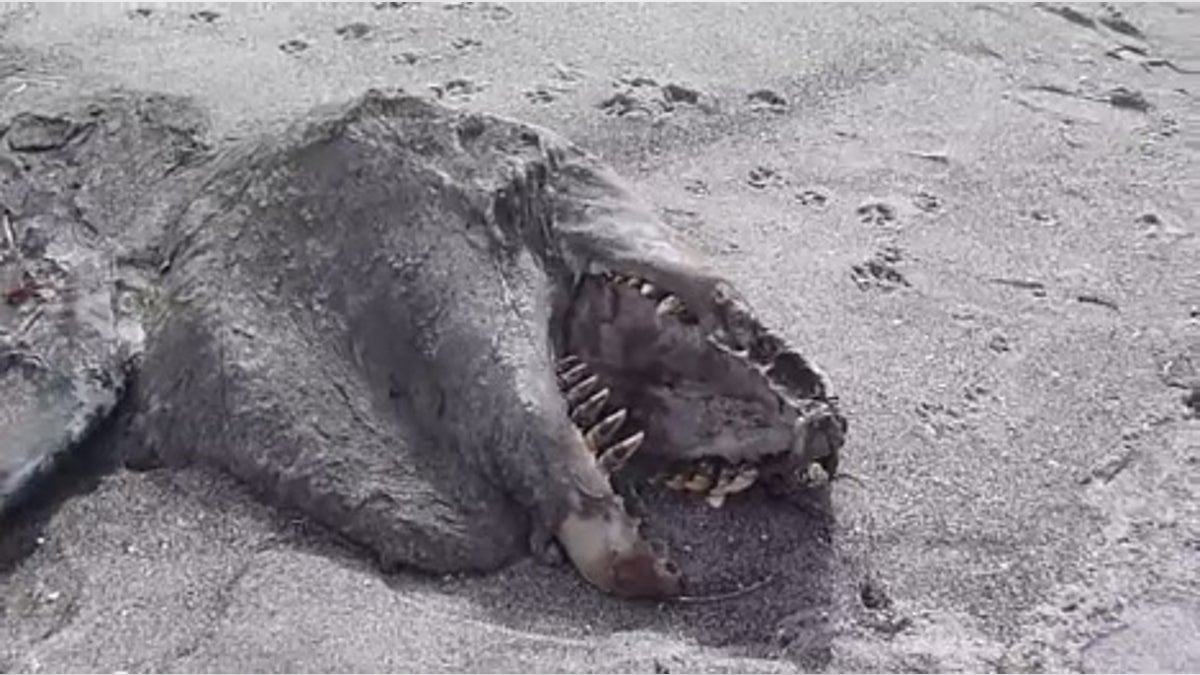
New Zealand beachgoers were stumped by what they thought was a prehistoric creature that washed ashore recently. (YouTube)
A mysterious carcass washed ashore in New Zealand last week, fueling speculation about sea monsters and dinosaurs. The rotting animal was discovered by a group on four-wheel vehicles speeding along the beach in Bay of Plenty.
According to a story in New Zealand’s Sun Live newspaper, “beachgoers were stumped when they came across what they thought was a prehistoric creature on the shore … stretching about 9 meters [30 feet] in length with large teeth and rudimentary flippers.”
Video of the fearsome-looking animal was soon posted to YouTube, asking the public for help in figuring out what it was.
PHOTOS: Sea Monsters Real and Imagined
A marine biologist soon identified the remains as a killer whale, in part because of its distinctive flipper. The mystery was solved, but it’s not the first time an animal’s carcass has been mistaken for a monster. In fact, New Zealand is one of the most common places in the world — along with Newfoundland, Canada and Florida — for such “sea monsters” to appear.
- Nature’s Oddities: The strangest creatures on earth
- Mythical creatures that continue to confound
- ‘Beast of Brooklyn’ washed up in New York
- Before Babel? Ancient mother tongue reconstructed
- Disputed dinosaur formally returned to Mongolia
- Bugged by the billions: East Coast about to see power of big numbers in coming cicada invasion
- Sun unleashes spectacular solar eruption
The Science of Sea Monsters
Over the past centuries mysterious masses of marine flesh have occasionally washed ashore on beaches around the world. Dubbed “blobsters” (or simply “blobs”) these large carcasses are so badly decomposed there’s not enough material to make a definitive identification. To many people, the huge creatures — looking unlike any known animal — may seem like strong evidence for sea monsters or even existing dinosaurs.
In 1896, giant waves tossed a massive fleshy corpse on a beach at St. Augustine, Fla. The rubbery, 6-foot-high blob was examined by a local naturalist, who decided it was likely from a giant octopus far larger than any known type. Many other such blobs have been found, including the horror-film inspired “Chilean blob” (found in July 2003), a few “Bermuda blobs,” and another in Newfoundland in 2001.
NEWS: Ancient ‘Loch Ness Monster’ Suffered Arthritis
Controversy and mystery surrounded the creatures for decades. In 2004, a team of biologists led by Sidney Pierce examined all available blobster materials using electron microscopes, and applied biochemical, molecular and DNA analysis. The conclusion: The strange specimens were actually various species of great whales.
Though the identities of these mysterious monster carcasses are now known, marine mystery lovers need not fret. The oceans have not been fully explored, and it’s certain that the sea has not revealed all its secrets.
